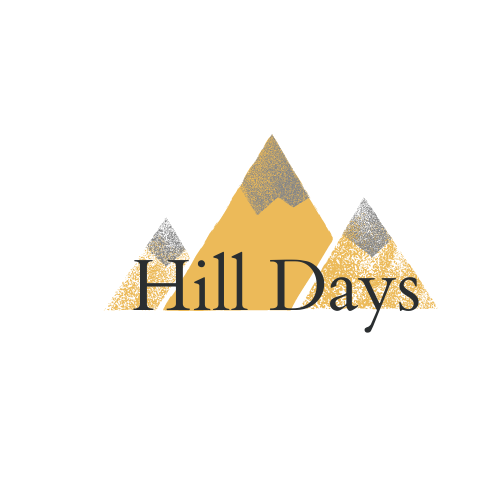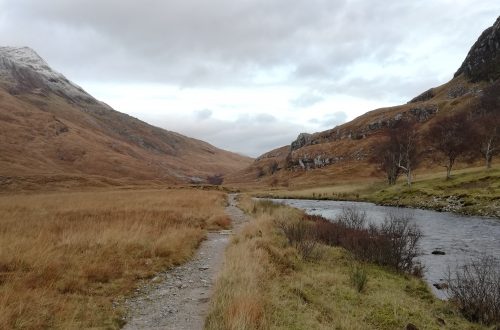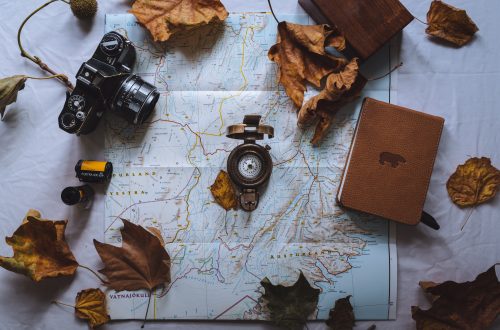
Compass Corner: Lesson 3 – Orientating Your Map to the Ground
Orientating a map to the ground is a key skill and an important building block for developing your navigation skills. Orientating a map can be done using a compass and matching the map north with the compass north. However, this lesson will focus on how to orient your map without the help of a compass. This is important and will help you learn how to identify and match features on the map and the ground. Orientating a map means simply to line up the features on the map with those on the terrain in front of you. When doing this the map north will always match with the north on the terrain. Correctly orientating your map will make it easier to interpret your map and follow your intended route. Read onward for how to orient your map using terrain features and for useful exercises to practice this important skill.
Always start by looking around before orientating the map
A simple mistake even experienced navigators make is to start by looking at the map. However, it is recommended to instead start by having a good look around yourself. Identify the key features you can see on the ground before you even glance at the map. Are there roads, paths, buildings, watercourses, forests, fences, hills or any other easily identifiable features nearby? Only after you know what kind of features to expect, should you look at the map. This may seem counterproductive, but it is surprisingly easy to make the landscape fit the map if you are already convinced you are looking at certain things. ‘Bending’ the landscape to fit the map is probably the most common navigation mistake. It is really easy to do even if you are an experienced navigator. And therefore, always starting with a good look around is an important habit to form early on!
How to orientate a map
It is a good habit to fold your map before heading out for a walk. Aim to fold your map so that it fits into a map case and ideally shows your entire route. For longer walks this might not be possible, so instead fold the map so that it shows the first half of your route. Folding a map like this might mean having to fold it against its existing folds, but this makes it easy to use and to handle! You can put your ready folded map into a map case, which will neatly hold it in position for the whole walk. But I have also seen people use clothes pegs and big paper clips for this purpose! In any case this will avoid you having to flap around with your sheet of a map on a windy hillside pre-walk!
Orientate your map already at your starting point, or the earliest possible opportunity, and keep reorientating it as you move along your route. Hold your map horizontally in front of yourself. The map in front of you should always match the terrain you can see. This makes it easier to stay on route, double check your location and progress. It also builds an important habit which will be the basis for more complex navigation later on! If you missed the first lesson on how to read maps, check here.
Start with the obvious features and work your way down
In order to orientate your map, start by checking the obvious features you can see on the ground. Are you on a road or a path? Are there streams or other watercourses visible? Any forests or buildings? In a situation where you are standing on a footpath and can see a stone wall running parallel to it on your right hand side and a footbridge over a little stream ahead of your, these are the features you should be looking for on the map! Make sure that the line representing the footpath on the map points to the same direction as the footpath on the ground. Next, make sure that the wall on your right-hand side is also on the right hand-side of the footpath on the map. Finally, check that the footbridge you can see on the ground is also there on the map!
There is nothing more difficult to orientating a map visually than this! If there aren’t obvious landmarks available to do this by, you might need to use more subtle features such as hills and slope angles. But we will get into those details later on in this series! And the chances are, if you are on terrain with no obvious features or poor visibility, you will need to use a compass for navigation anyway. I will be introducing the compass and how to use it in lesson 5!
It’s important to keep turning the map!
The key to orientating your map is to keep doing it frequently as you progress along your route. If you take a turn 90 degrees off your initial footpath, the map also needs to turn 90 degrees. The lines on the map now need to match the new things you can see in front of yourself. Keep thinking of the map as a miniature representation of the landscape and make sure you can continuously see the same things on both!
Troubleshooting for issues
It is normal to make mistakes when navigating, and more so when you are still learning. The most common reason for making mistakes is simply a lapse in focus. This maybe due to you being tired, cold or hungry, or maybe due to chatting with a friend and forgetting to focus on the task at hand. I usually get a slightly uneasy feeling when things are starting to go wrong. Usually just a slight detail on the ground is not matching what I was expecting to see based on the map anymore. Maybe the ground is starting to slope to the wrong direction, or I spot an outcrop or a stream that I wasn’t expecting.
This in itself is not necessarily cause for concern and sometimes the map is not a 100% representation of what is on the ground. Watercourses change places or dry up. Forests are felled or expand between maps being updated. Sometimes new roads and paths get built. However, I have learned to listen to my feelings. If I feel uneasy, it is worth stopping and just reaffirming that everything is as it should be. I recommend you learn to do this too! Especially as you are learning, stop frequently and double check that the map and the terrain are still in agreement. It is much easier to catch mistakes early when you have only just started to veer off the intended course.
Also remember that you can always orientate your map using a working compass!
Useful exercises to practice orientating a map
Exercise 1:
Find a field or a bit of empty flattish ground with a bit of space around you. Orientate you map to the ground. Then start walking in a small circle and keep your map orientated the whole time! This will require you to keep turning the map in your hands. Make sure you are facing along the circle and not turning your body instead of the map in your hands!
Exercise 2:
Walk along a route you are already familiar with (so no active navigation is needed). Stop every 10-15 minutes and take your map out and orientate it to the ground. Do not look at the map as you are walking! Instead start from scratch each time by looking at your surrounding and then find the location on the map. This is ideal for practicing orientating your map, but also relocating yourself on it!
Exercise 3:
This exercise works to build your skills from actively orientating your map to navigating using the map alone (which is the topic of the next lesson!). So at the start of your walk, orientate your map. Then have a look at the next 1km on the map along your intended route. (It will most likely take you 15-20 minutes to leisurely walk this distance). What things are you expecting to see on the ground during this time? By looking at the map, build up a story of the things you will encounter. Will you maybe walk along a path, cross a river before coming to a fence, then turn left at a junction and reach the edge of a crop of trees?
Whatever, there is that you can see on the ground will also be represented on the map to some extent. Knowing what to expect on the ground will allow you to navigate along without even thinking about it! Ticking off the expected features one by one
will allow you to stay on your intended course without the need to keep checking the map. And in no time, you will be confidently navigating along by just visually matching the ground to the map and vice versa!
You might also be interested in:
To follow my personal outdoor adventures and get more useful outdoor content, have a look at my Instagram and Pinterest accounts!
Other in the Compass Corner Series:
Compass Corner Navigation Lessons Syllabus
Compass Corner: Lesson 1 – How to Read a Map
Compass Corner: Lesson 2 – Why are Grid References so Important?





